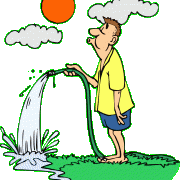Watering Tips
WATERING TIPS
To be an effective gardener, put the watering can aside and use soaker hoses or a drip irrigation system to keep your garden and flowers happily growing. You can make your job even easier by hooking either one up to an automatic timer.
Here are 5 easy tips!
1. Mulch, mulch, and mulch some more!
Cover your soil with a blanket of organic material such as straw, leaves, or shredded paper. This will keep your soil cooler, prevent water runoff, lesson evaporation, and hold moisture in the soil for longer periods between waterings.
2. Water deeply.
Less frequent, deeper waterings are more effective in promoting deeper and stronger roots. Frequent shallow waterings cause roots to grow closer to the soil surface where there is higher temperatures and evaporation.
Push your finger down into the soil to check for moisture. If the soil is cool, it is still moist. If the soil is warm to the touch, it is time to give a long slow soak.
3. Use soaker hoses or drip irrigation and an automatic timer.
Watering slowly allows the moisture to soak into the soil and permeate down to the root level.
Drip lines, provide very slow and effective irrigation. It also cuts back on leaf diseases by injecting the water directly in the soil instead of it sitting on the leaves of your plants.
A drip system or sprinkler can be attached to timers, which you can set for automatic, daily or regular watering cycles.
4. Mix water-absorbing materials into your soil.
Organic material, peat moss, leaf mold or even plain old compost, will absorb a few times its own weight in water, thus retaining moisture that plants can use during dry spells. Organic material also improves the structure, aeration and overall health of the soil.
Another alternative are polymer crystals that absorb water. Mix these into your soil to increase its water-holding capability. Soil Moist is a very good product, and we actually add it to our growing medium.
5. Try a self-watering container.
Self-watering containers are great for container gardening. The water is held at the bottom of the container and allows plants to grow their toots toward the water and drink as needed.

